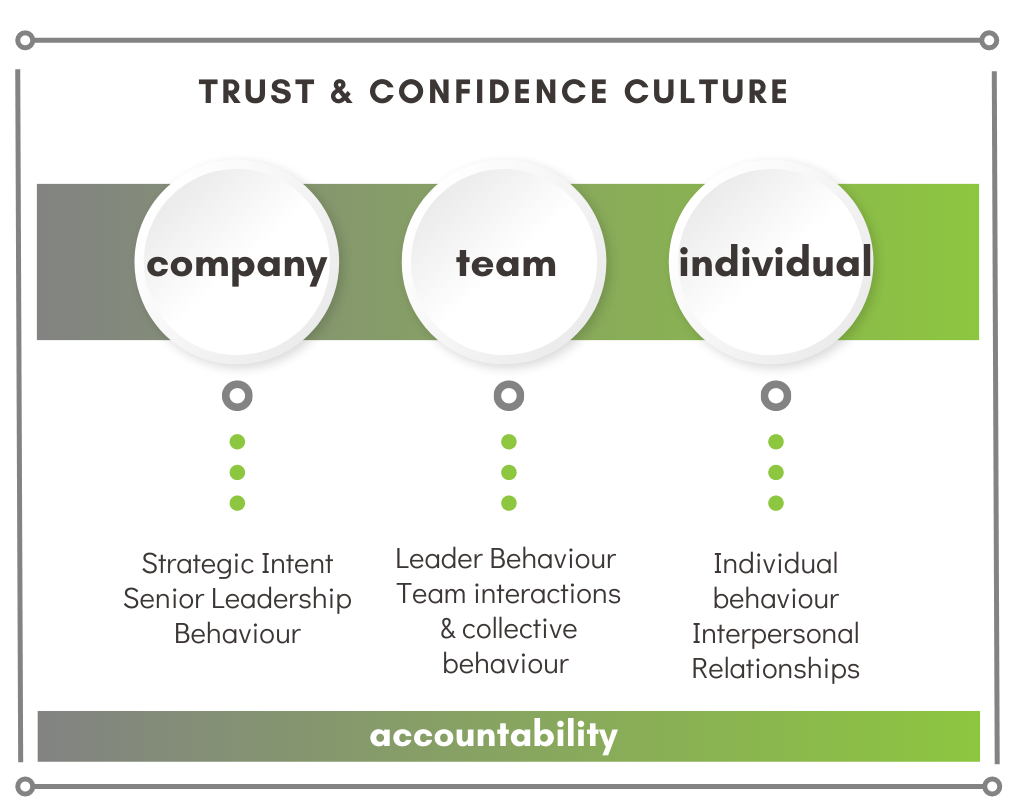
Written by Marnie Brokenshire
August 22, 2022
Prior to a long awaited landmark decision in the High Court, we HR practitioners considered the concept of “trust and confidence” as a legal construct, not a culture construct.
In short, the implied term of “trust and confidence” was a legal mechanism we understood as a factor in consideration of the performance of an employment contract. After this High Court decision, it all got a bit murky (if you are interested in the decision, click here) – but that’s not the point of this article.
The point is, as a result of this industrial concept, we never really focussed on trust and confidence as a premise of culture, well at least I didn’t. It wasn’t a foreign concept – phrases such as “he’s not trustworthy”, “she can’t be trusted”, “the managers don’t trust us” were not uncommon, but I’m not sure the HR community really thought about “trust” as a premise for building psychologically safe, diverse and inclusive teams in their people strategies. We should have! We do now.
In part thanks to the buzz around “psychological safety”. This article is not about psychological safety per se, rather, the premise of “psychological safety” is a consequence of a trusting culture, and that is where to start.
In 2001, Jim Collins wrote a book called “Good to Great…why some companies make the leap and other’s don’t”. The importance of building trust and respect was a major theme of his ideology. He advanced the concept of “safe environments”, so the premise of “psychological safety” is far from new. I read this book in 2001, yet I didn’t really take the baton and run, I was too busy focussing on hedgehogs and foxes (google it) or click here.
Not long after I realised fast what happens in an organisation where there is no trust and how damaging that can be. I revisited Jim Collins’ book as a starting point for building trust principles into my people strategy and my leadership development training.
We say, ‘no trust, no chance’.
For completeness, lets quickly define “psychological safety in the workplace”. Broadly it is as an environment in which people are comfortable expressing and being themselves, where inclusivity and diversity of thought (as well as a true expression of individuality and individual characteristics), are truly embraced. Where you can speak your mind, speak up or out, and this will be considered a good thing in all circumstances, no matter how controversial. Where judgement is not made, you are not labelled (“opinionate”, “high maintenance”, “vocal”) and there is no blame game. So basically, an environment of high trust and high confidence.
This brings me to Hertzberg. For years now, I have preached the principles of Herzberg’s two-factor hygiene-motivation theory. I’ve even gone as far as to include the actual theoretical teachings in leadership programs for all levels (which I rarely do). For those who want to review Herzberg’s theory, click here. Simply put; until you get the environmental hygiene factors right it doesn’t matter what you do, it won’t work and it won’t stick.
All of this means that without a base level of trust, where you trust your employees and they trust you, you can throw as much mud at the wall as you like but it won’t stick, you won’t drive change and your culture will be flawed.
“Without trust and confidence as a cornerstone of your ‘hygiene factors’, you won’t achieve anything close to a culture that inspires all the good things where people grow and thrive. Or, as I also commonly say, you can’t build a house on shaky foundations.”
How do you do it?
This is to get you thinking…it’s a complex matter and a highly customised approach is necessary to get it right, but in short, trust and confidence should be thought of in 3 categories as depicted in this model:

In developing your strategy, you need to ensure that initiatives are tailored at a company level, team level and individual level. In an ideal situation, you would start at the top, influence the strategy and develop initiatives that are role modelled from the top down.
However, in my experience sometimes the best place to start is in the middle, at a team level with department/line managers. Given that department/line managers tend to have the most day to day interaction with the workforce, this can be the most effective. This is also true if the senior leadership at the most senior levels of the organisation have issues with dysfunction or ineffectiveness.
In each category there must b a program of accountability that is managed and measured!
The focus should be on developing capability in behaviour that builds trust and heavily weighted towards building emotional intelligence competencies. The below list of questions is a good guide to anecdotally measure where you are at and if you need to do work.
To claim trust in culture, you need to be able to say (and measure) that:
- Everyone is held accountable for their own behaviour – leaders are role models for inspiring engagement, they don’t play favourites, they nip issues in the bud quickly, they are good communicators and they play to people’s strengths
- Your managers know their people well and they authentically care about their success and well being
- Your managers never own someone else’s success, they recognise that they have done a good job when their employee’s succeed and they openly acknowledge and praise them
- Your leaders think and act like a collective and are not hierarchical
- There are mechanisms in place for people to share opinions, thoughts and ideas, openly and frequently and without ramification
- There is no blame game – the question is “what can we learn/do better” not “who did it or whose fault is it”?
- You have a robust approach to addressing people who do not play by the rules
- You can describe your culture as humble, authentic and respectful
- Communication is frequent and two way
- Trust is a default mindset
If you can answer yes to these questions, bravo – you are doing extremely well. If you can’t you have work to do, but it is worth doing. Once you trust your workforce, they will trust you. Trust begets trust, it is simple but true.
We tailor specific strategies and initiatives that build trust and confidence. Reach out to discuss our solutions and learn more about our case studies. If you would like to receive a more comprehensive health check, send us an email.
As practitioners with years of in-house Corporate experience, we know the role of HR is hard, we also know that becoming strategic, influential and value add is a journey supported by mentoring. This is why we offer people strategy workshops and HR masterclasses facilitated by Marnie Brokenshire (30+ years corporate HR, 15 at C-Suite), and Nicole Mathers (10+ years corporate HR, 5 at senior management). Reach out to see how we can support you.
Related Articles
Why you should be doing stay interviews.
We are noisy about the use of culture surveys - we think they rarely tell you what you really need to know and should be used sparingly - read here....
Why are we still dealing with bullying, harassment & discrimination?
Statistically, bullying and harassment in the workplace is as bad as ever. Despite the #metoomovement, the events of parliament and countless...
Are you still doing traditional performance reviews?
In 2015, PWC surveyed the ASX top 150 regarding performance reviews. The survey found that most high performing businesses acknowledged their...
Subscribe
Follow Us
We welcome a discussion to see if we can meet your needs.






0 Comments